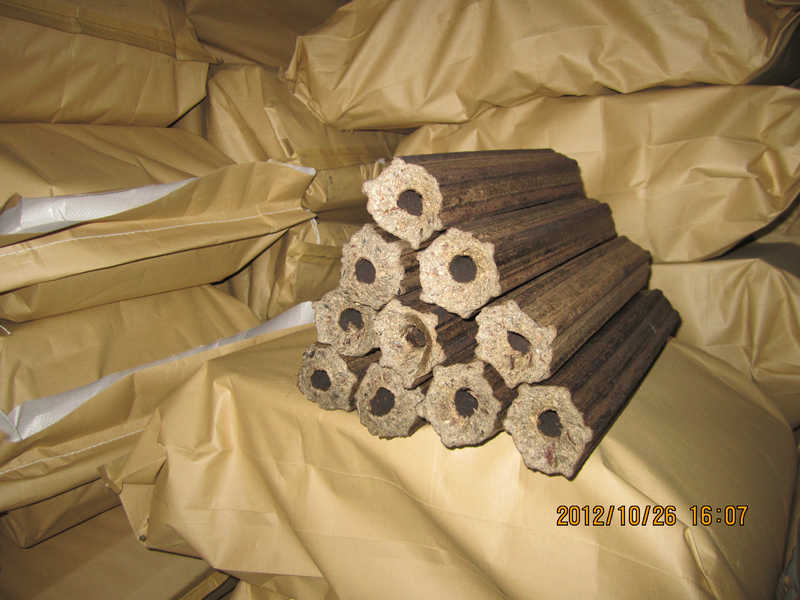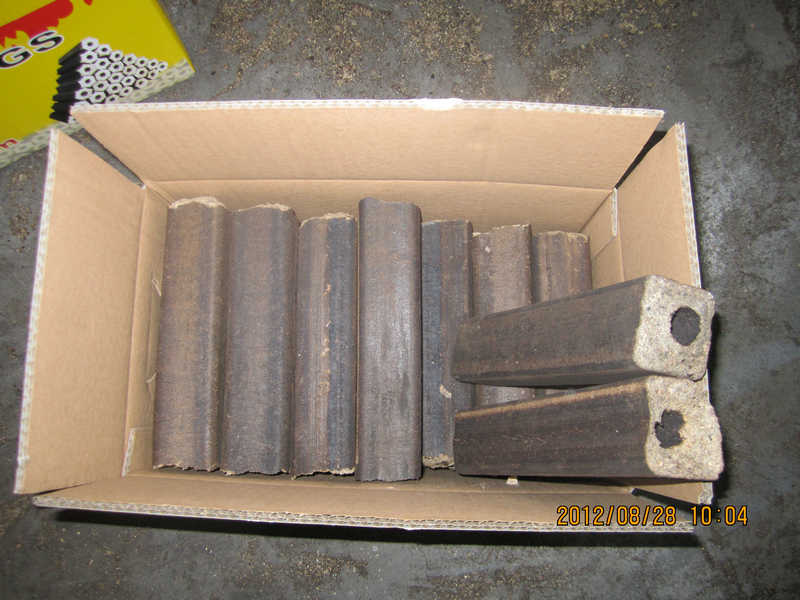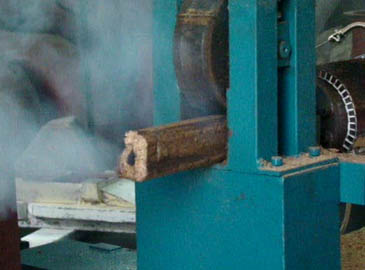What is Briquette(1)
Excerpted from Developing Energy Enterprises Project East Africa (DEEP EA)
Briquettes Production


1. Technology Basics
Fuel briquettes are blocks of compressed biomass material such as farming waste, charcoal dust or waste paper. The prices of firewood and charcoal have been increasing dramatically, making it less affordable for most users. Briquettes are a proven technology that provides a low cost fuel for households that is locally made and an alternative to wood or charcoal. Fuel briquettes can also be used in institutions for large scale cooking, and in industries for productive use.
Briquettes are a household and institutional fuel, made by compacting biomass waste. Read on for more about this simple technology. Applications Briquettes have a wide variety of use from household to industrial. The fuel has not been fully exploited as there has not been scarcity of fuel in the past. However, with the current fuel shortage and ever rising prices, consumers are looking for affordable alternative fuels and briquettes fill this gap for:
-
Cooking and water heating in households;
-
Heating productive processes such as tobacco curing, fruits, tea drying, poultry rearing etc;
-
Firing ceramics and clay wares such as improved cookstoves, pottery, bricks etc;
-
Fuel for gasifiers to generate electricity;
-
Powering boilers to generate steam.
Two types of fuel briquettes exist in the market
1. Non-carbonized fuel briquettes. These are produced from waste materials that are not carbonized such as sawdust and waste paper.
2. Carbonized fuel briquettes. These are made from waste materials that have undergone carbonization such as charcoal dust, or carbonizing non-carbonized briquettes.
Benefits
Briquettes can potentially offer the following benefits over traditional biomass fuels (firewood or charcoal):
Uniformity and standardisation;
Could be tailored to the particular usage. i.e. long burning time, stove types (institutional or households), smoke and ash levels among others;
Lower overall fuel costs for users as they are made from biomass waste.
A Briquette
Briquettes are made from raw materials that are compacted into a mould. Briquette could be made of different shapes and sizes depending on the mould. The appearance, burning characteristics of briquettes depends on the type of feedstock and the level of compactness and the mould used.
The size and shape should be designed to match the market (Stove to be used). For household use, a high surface area (compared to its weight) is needed to enhance burning. This helps to make combustion uniform and complete, reducing harmful gases and smoke. This can be achieved by: a) having a hole(s) in briquettes, or b) making small briquettes commonly referred as pellets, say half the size of a mug.
Feedstock
The choice and availability of feedstock can make or break your business! A common feedstock to use is charcoal dust (particles of charcoal too fine to be sold). But other combustible material can potentially be used too, including: saw dust, bagasse, coffee husks, maize cobs, wheat/beans/barley straws and charcoal dust. For example, Figure 3 shows a mountain of saw dust in readiness for briquettes production! For one to produce quality briquettes, a number of factors need to be taken into considerations such as: moisture content, calorific value of the feedstock, smoke levels and ash content. In most cases (unless a powerful machine is used) a binding agent is added. Clay is common. There is also an added benefit to using clay: it can lower the rate of burning, so less heat is produced but for a longer period.

how to made briquettes
Biomass briquettes are made by pressing loose biomass residues or waste, to produce compact solid blocks of different sizes and shapes. They are made by applying pressure, heat and binding agent to the loose material to produce the briquettes of different shapes and sizes. The size and shape ca be designed to match the market needs.
Process options
Carbonised process: In this process the feedstock is first partially burned in an environment where fresh air is controlled. The process is known as charring or carbonisation. Once carbonised, the materials are then compacted using a briquette press. The advantage with carbonised briquettes is that they are virtually smokeless – a key consideration for household users. Carbonising kilns range from the very simple (a hole in the ground, covered by turf) to more complex and more efficient designs. For example, Figure 4 shows a carbonising kiln from Appropriate Rural Technology Institute (ARTI), India. It is a portable cylindrical structure about 150cm wide with 100 cm tall made out of sheet iron or a used drum:
A very common practice is to make briquettes from charcoal dust that has already undergone carbonisation. Non-carbonised process: This is the process of making briquettes without first carbonising them. The biomass materials are simply prepared and compacted to produce briquettes. This is simpler (and cheaper) process for a micro and small scale enterprises than carbonising – but only suited to applications where smoke is not an issue. However, for industrial applications, it requires sophisticated machines to attain the level of compactness required.
Briquette machine
Briquettes can be made by hand. Feedstock is mixed with water and a binder, moulded into balls and left to dry. This is an easy way to get your business off the ground and there is no excuse for not giving it a go! However, machines can potentially:
1) add value to the product
2) increase the amount of briquettes a single person can produce in a day.
Briquette machines range from simple manual press to a fully motorized and complex type. The main thing to consider is how many briquettes you want to produce and this will narrow down the type of
briquette machines required. For start-ups, a manual briquette machines might be appropriate, as it may not require too much investment. If you want to start a briquetting business, please feel free to contact us, KMEC would provide you with professional advice and perfect service. All kinds of briquette machine are available here to meet all of your requirements.
------------------------------------------------------------------------------------------------------------
Kingman briquettes making machine and biomass briquette machine will bring you a lucrative biomass briquette and charcoal fuel market. Hereby we can map out the prospect of using briquettes making machine and and biomass briquette machine.


